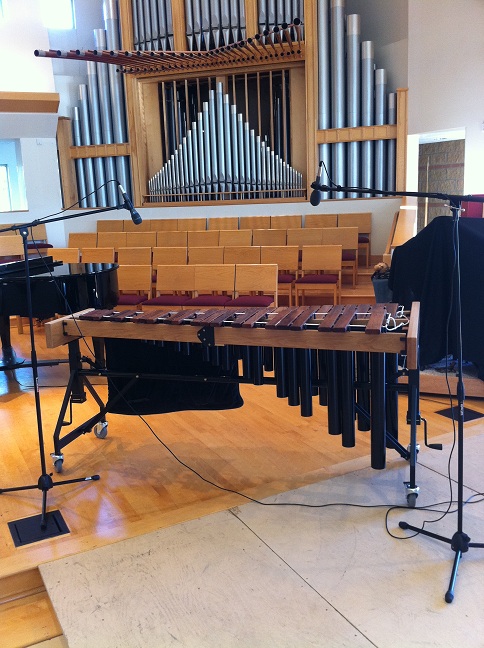It's THAT day of the week. I'll give you a hint: opposite of church-musician Wednesdays and not quite our Sundays either. After a quick stint as a person of Pinterest and oaty kitchen experimentation (and inventing the word "oaty"), I ran my usual 5k+, practiced Jan Bender's imitative, quartally-infused prelude on "Come, Ye Faithful," and read young-adult fiction on a sunny, cavernous library chair.
It could have held five of me. At least one of us would have finished before dozing off.
I discovered ten other things this week:
1. My usual running route, going down the parkway on the hill and turning around, has multiple ways of getting back up the hill. What.
2. When I forget my music in choir, my sightreading experience is such that I can read my line off of a Soprano II's score across the room.
3. Universal justification and objective justification differ from one another.
4. Tiffany blue is one of the prettiest and most versatile colors.
5. You miss the little, fidgety characteristics that bother you about someone first when he or she leaves. Think about it.
6. You can derive an individual's entire personality from how they sneeze. I double-sneeze, so that must mean I'm bipolar.
7. Tropical fruit topped with flake coconut, molasses and sunshine is the best antidote to a reluctant spring.
8. One of the first classes taught in Music Skills should be standing in front of the photocopier, figuring out what way to turn the music book.
9. Having a leaky sanctuary ceiling over where the baptismal font sits can be a self-fixing problem.
10. Johann Gerhard's Theological Commonplaces set forth doctrine a lot more accessibly than other dogmatic expositions. He likes to make lists, just as I do. :)
How about you?
Saturday, March 29, 2014
Monday, March 24, 2014
Mission Theology and the Image of God
 A proper, Lutheran theology of missions
easily centers around the concept and image of God because His being and
attributes, as the source of everything good, contain everything needed to know
about salvation.
A proper, Lutheran theology of missions
easily centers around the concept and image of God because His being and
attributes, as the source of everything good, contain everything needed to know
about salvation. First, one should learn of His triune nature and its specific connection with the redemption story: the Father sending His Son, the Son’s vicarious work, and the Holy Spirit’s bringing to faith and sanctifying. Studying His power, one sees that He is able to provide everything necessary for salvation, and anything outside of Him is weak and powerless. Examining His eternal nature, one understands Him as being beyond time, before sin started and lasting after sin ends. In His immutability, the person should realize that He is the One that never changes, letting go of love for changeable, temporal possessions. Connecting His immutability with His truthful nature, the new believer should understand that God is just, rewarding good and punishing evil, and that no error can be tolerated in His sight – unlike our wavering sense of morals. Noting His omniscience, the person could and should see that the just Lord of all knows about every sin, closing any path of escape, but also that He knows the condition of the sinner’s deep degradation and exactly how to rescue him or her. In His omnipresence, any place of “hiding” proves to be of no avail, but this also assures that God always knows our situation and how to protect us from any harm and danger.
Looking at God’s love, anyone ought to be
moved to love Him more and carry out love for others, knowing that He has set
the ultimate example in the sending and self-sacrifice of His Son, and noticing
nothing but self-service in the world.
Learning about His goodness, one should recognize that He alone supplies
good in the world, and all other motivations and acts of men are driven by an
evil, sinful heart. In His graciousness, one should compare His bestowing of
goodness (ultimately eternal life) as a free gift aside from merit, whereas any
human being requires some self-gratifying deed in return for another.
Most of all, the person reached by this missionary
theology should be taught that these features of the image of God are for him
or her. God’s image is the way it is
without being dependent on man’s need or humanity, but He particularly
determined for His attributes to work together, as we speak of it, to bring
about our salvation as He willed it from eternity in time. With instruction about the image of God, the
new convert must discover that His characteristics that motivated our
redemption from sin are like no other religion’s deity, including the theology
of self.
Saturday, March 15, 2014
Cantata No. 31: The heavens laugh, the earth rejoices!
How do you get an SATB choir to laugh in sync? Bach figured it out. No, it has nothing to do with backrubs.
Cantata No. 31 lands on Easter in the liturgical year, rendering its D-major, brass-amplified quality fitting.
Excitedly, the trumpets blast three times, giving Christ's resurrection a worthily royal fanfare akin to
While the choir awaits springing upon the congregation in jubilatory noise, the orchestra builds the excitement with a symbolically rising fanfare motif. When the voices do enter, the hearers are not disappointed!
As if to explain, the bass tells the good news that Jesus, the "A and O," has risen, and because of this fact each of the "letters" in-between, the limbs to the Head, must share in this life. Praising the "Prince of Life" directly, the soloist rhetorically asks in a laughing, dotted rhythm about the events intended to mock Him. Does the cross upraise him to the highest throne (melisma rocketing upward on "highest")? Are his bonds now His majestic decoration? Are His purple wounds now His clear radiance? Yes., yes, and yes.
 Now, pointing to the believer's life in sanctification, the tenor jumps in instead with a recit and aria, exhorting to see the third function of the law. As Colossians 3:1 admonishes, "If you then be risen with Christ, seek those things which are above, where Christ sits on the right hand of God." Likewise, he gives the listener a nudge to run from the tomb and graveclothes as Jesus has done, because they are among the living. With the strings scrubbing busily away, he explains that the Adam within must die before life as Christ's member begins.
Now, pointing to the believer's life in sanctification, the tenor jumps in instead with a recit and aria, exhorting to see the third function of the law. As Colossians 3:1 admonishes, "If you then be risen with Christ, seek those things which are above, where Christ sits on the right hand of God." Likewise, he gives the listener a nudge to run from the tomb and graveclothes as Jesus has done, because they are among the living. With the strings scrubbing busily away, he explains that the Adam within must die before life as Christ's member begins.
Cantata No. 31 lands on Easter in the liturgical year, rendering its D-major, brass-amplified quality fitting.
Excitedly, the trumpets blast three times, giving Christ's resurrection a worthily royal fanfare akin to
While the choir awaits springing upon the congregation in jubilatory noise, the orchestra builds the excitement with a symbolically rising fanfare motif. When the voices do enter, the hearers are not disappointed!
As if to explain, the bass tells the good news that Jesus, the "A and O," has risen, and because of this fact each of the "letters" in-between, the limbs to the Head, must share in this life. Praising the "Prince of Life" directly, the soloist rhetorically asks in a laughing, dotted rhythm about the events intended to mock Him. Does the cross upraise him to the highest throne (melisma rocketing upward on "highest")? Are his bonds now His majestic decoration? Are His purple wounds now His clear radiance? Yes., yes, and yes.
 Now, pointing to the believer's life in sanctification, the tenor jumps in instead with a recit and aria, exhorting to see the third function of the law. As Colossians 3:1 admonishes, "If you then be risen with Christ, seek those things which are above, where Christ sits on the right hand of God." Likewise, he gives the listener a nudge to run from the tomb and graveclothes as Jesus has done, because they are among the living. With the strings scrubbing busily away, he explains that the Adam within must die before life as Christ's member begins.
Now, pointing to the believer's life in sanctification, the tenor jumps in instead with a recit and aria, exhorting to see the third function of the law. As Colossians 3:1 admonishes, "If you then be risen with Christ, seek those things which are above, where Christ sits on the right hand of God." Likewise, he gives the listener a nudge to run from the tomb and graveclothes as Jesus has done, because they are among the living. With the strings scrubbing busily away, he explains that the Adam within must die before life as Christ's member begins.
Recalling Job's words, "For I know that my Redeemer lives, and He shall stand at last on the earth;
26 and after my skin is destroyed, this I know, that in my flesh I shall see God" (Job 19:25-26), the soprano's plaint to be drawn together with the Lord ensues. Turning to joy, the vocalist realizes that suffering with Him leads to honor, glory, and seeing God in the flesh, culminating on sudden leaps to lofty notes.
Next, the accompanying aria "Last hour, break forth!" includes an echoing, clock-like oboe pattern and simple, plodding continuo as the person asks for closed eyes so that Jesus and His glow might appear instead. At that moment, the string "halo" drifts in, quoting a later verse of Nikolaus Herman's "When My Last Hour Is Close At Hand," beginning "Since You have risen from the grave..." and stating faith in the believer's own resurrection.
To close, the whole choir in five parts completes the instrumental chorale, commending their spirits to Jesus' care with outstretched arms, and trusting that He will open Heaven's gate to them - the strength of their own pulling and knocking is not necessary.
So many contrasts and paradoxes: heaven and earth, the Alpha and Omega, humiliation and exaltation, stained robes and bright glory, Adam and the Son of Man, death and life, eyes closed and opening again, and the sinner's misdeeds covered by Christ's righteousness. Definitely something to laugh (jubilantly) over!
Translation: http://emmanuelmusic.org/notes_translations/translations_cantata/t_bwv031.htm
Score: http://conquest.imslp.info/files/imglnks/usimg/f/fb/IMSLP00920-BWV0031.pdf
Recording: http://www.youtube.com/watch?v=TybhYCwTN30
Sunday, March 2, 2014
Sunday morning in paradise
So, today where I live, it is -7 degrees outside. When I arose this morning, this is what I saw from my lofted bed:
The completely frozen-over parking lot looked like this.
Then, I had one of these for breakfast:
Accompanied by something refreshing to wake me up for 9:40 senior choir rehearsal:
Looking out from the kitchen, I mused how I might get to church three-quarters of a mile away. The windchill was -30 below.
Then, I bundled up and made a wild leap of faith into the frigidness.
At church, everyone was still in early service for Communion Sunday. Surrounding it, the snowbanks and roads were clearly a mess. I'm amazed they all got there all right!
Yet, nonetheless, I got inside, un-mummified myself with winter garments, and warmed up on the keys.
The Lord was certainly watching over me all the way there!
Subscribe to:
Posts (Atom)










